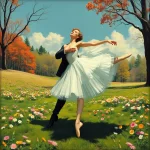Ballet: Appalachian Spring (Aaron Copland, 1944)

Introduction
Ballet: Appalachian Spring is a seminal work in the American ballet repertoire, composed by Aaron Copland in 1944. The ballet was choreographed by the legendary Martha Graham, and it premiered on October 30, 1944, at the Library of Congress in Washington, D.C. The ballet tells the story of a young frontier couple on their wedding day, capturing the essence of American pioneer spirit and optimism.
Historical Background
Creation and Development
The creation of Appalachian Spring occurred during a period of significant historical, social, and artistic change. The United States was in the midst of World War II, and there was a strong sense of national identity and pride. This context influenced both the music and the choreography, which sought to capture the American spirit.
The inspiration for the ballet came from American folklore and the pioneering spirit of the early settlers. Martha Graham, who was deeply interested in American themes, collaborated closely with Aaron Copland to bring this vision to life. The title “Appalachian Spring” was suggested by Graham, inspired by a poem by Hart Crane, although the ballet itself does not directly reference the poem.
The collaboration between Graham and Copland was a harmonious one, with both artists bringing their unique talents to the project. Graham’s innovative choreography and Copland’s evocative score combined to create a work that was both groundbreaking and deeply moving.
Premiere and Reception
The ballet premiered on October 30, 1944, at the Library of Congress in Washington, D.C. The initial reception was overwhelmingly positive, with critics and audiences alike praising the work for its originality and emotional depth. The ballet quickly became a staple of the American ballet repertoire, with notable early performances by the Martha Graham Dance Company and revivals by other major ballet companies.
Synopsis of the Ballet
Appalachian Spring is a one-act ballet that unfolds in a series of scenes depicting the life of a young frontier couple. The ballet is set in rural Pennsylvania in the early 19th century and captures the joy, hope, and challenges of pioneer life.
Key Moments
- Introduction: The ballet opens with a serene and pastoral scene, setting the stage for the story to unfold.
- The Bride and Groom: The young couple is introduced, and their love and excitement for their new life together are evident.
- The Revivalist and Followers: A preacher and his followers enter, bringing a sense of community and religious fervor.
- The Wedding: The central scene of the ballet, where the couple is married, symbolizing hope and new beginnings.
- Celebration: The community comes together to celebrate the wedding, with lively dances and joyful music.
- Conclusion: The ballet ends on a hopeful note, with the couple looking forward to their future together.
Musical Composition
Composer’s Role
Aaron Copland, one of America’s most celebrated composers, played a crucial role in the creation of Appalachian Spring. His score for the ballet is considered one of his masterpieces, characterized by its simplicity, clarity, and evocative use of American folk melodies. Notable pieces within the score include the “Simple Gifts” theme, which has become iconic in its own right.
Musical Themes and Motifs
The music of Appalachian Spring is rich with recurring themes and motifs that enhance the narrative and emotional depth of the ballet. The “Simple Gifts” theme, a Shaker melody, is perhaps the most famous, symbolizing the purity and simplicity of pioneer life. Copland’s use of open harmonies and folk-inspired melodies creates a sense of space and freedom, perfectly complementing the ballet’s themes.
Famous Recordings and Performances
There have been numerous iconic recordings and performances of Appalachian Spring’s music. Leonard Bernstein’s recording with the New York Philharmonic is particularly renowned, as is the original recording by the Martha Graham Dance Company. These recordings have helped to cement the ballet’s place in the American cultural canon.
Choreography and Dance
Choreographer’s Vision
Martha Graham’s vision for Appalachian Spring was deeply rooted in her interest in American themes and her innovative approach to modern dance. Her choreography for the ballet is characterized by its use of angular movements, grounded poses, and expressive gestures, all of which convey the emotional depth and resilience of the characters.
Signature Dance Numbers
Key dances in Appalachian Spring include the Pas de Deux between the Bride and Groom, which is a tender and intimate portrayal of their love, and the lively group dances that celebrate the community’s joy and unity. Graham’s choreography reflects the story and characters through its use of space, movement, and emotion.
Notable Interpretations
Over the years, different productions have brought their own interpretations to the choreography of Appalachian Spring. Some have emphasized the ballet’s historical context, while others have focused on its emotional and psychological depth. These varied interpretations have kept the ballet fresh and relevant for contemporary audiences.
Characters and Roles
Main Characters
- The Bride: A young woman full of hope and excitement for her new life.
- The Groom: The Bride’s partner, equally hopeful and committed to their future together.
- The Revivalist: A preacher who brings a sense of community and religious fervor.
- The Pioneer Woman: A wise and experienced woman who represents the strength and resilience of the pioneer spirit.
Supporting Characters
The supporting characters include the followers of the Revivalist, who add to the sense of community and shared purpose in the ballet. These characters, though secondary, play an important role in creating the world of the ballet and enhancing its themes.
Famous Dancers
Notable dancers who have portrayed these roles include Martha Graham herself, who originated the role of the Bride, and Erick Hawkins, who played the Groom. Their performances set a high standard for future interpretations of these roles.
Cultural and Artistic Impact
Influence on Ballet and Dance
Appalachian Spring has had a profound influence on ballet and modern dance. Its innovative choreography and evocative music have inspired countless choreographers and composers. The ballet’s focus on American themes also helped to establish a uniquely American voice in the world of dance.
Cultural Significance
The ballet’s place in popular culture is significant, with references and adaptations appearing in literature, film, and other media. Its themes of hope, resilience, and community resonate with audiences across generations, making it a timeless work.
Legacy and Revivals
Appalachian Spring continues to be performed and celebrated today, with major revivals by leading ballet companies around the world. These revivals often bring new interpretations and fresh perspectives to the ballet, ensuring its continued relevance and appeal.
Iconic Productions
Historic Productions
Historic productions of Appalachian Spring include the original 1944 premiere by the Martha Graham Dance Company, which set the standard for future performances. Key figures involved in these early productions include set designer Isamu Noguchi, whose minimalist designs perfectly complemented Graham’s choreography.
Contemporary Productions
Recent productions of Appalachian Spring have brought new interpretations and innovations to the ballet. These contemporary performances often incorporate modern elements while staying true to the original vision of Graham and Copland. Differences from the original productions may include updated set designs, new choreography, or reinterpretations of the characters.
Production Design
The set, costume, and lighting design in various productions of Appalachian Spring have played a crucial role in bringing the ballet to life. Isamu Noguchi’s original set design, with its simple and symbolic elements, remains iconic. Contemporary productions may experiment with different design elements to bring new perspectives to the ballet.
Critical Reception and Reviews
Initial Critical Response
The initial critical response to Appalachian Spring was overwhelmingly positive. Critics praised the ballet for its originality, emotional depth, and innovative choreography. The collaboration between Graham and Copland was particularly lauded, with many noting how seamlessly the music and dance complemented each other.
Modern Reviews
Contemporary critics and audiences continue to hold Appalachian Spring in high regard. The ballet is often praised for its timeless themes and its ability to resonate with modern audiences. Its relevance today is attributed to its universal themes of hope, resilience, and community, as well as its innovative artistic elements.
Fun Facts and Trivia
Behind-the-Scenes Stories
One interesting anecdote from the production of Appalachian Spring involves the title itself. Aaron Copland initially composed the music without a specific title in mind. It was Martha Graham who suggested “Appalachian Spring,” inspired by a line from Hart Crane’s poem “The Bridge.”
Notable Performers
Famous dancers associated with Appalachian Spring include Martha Graham, who originated the role of the Bride, and Erick Hawkins, who played the Groom. Their performances have become legendary in the world of dance.
Trivia
- The ballet was awarded the Pulitzer Prize for Music in 1945.
- The “Simple Gifts” theme used in the ballet is a traditional Shaker melody.
- Isamu Noguchi’s set design for the original production is considered a masterpiece of minimalist design.
Conclusion
Summary of the Ballet’s Importance
Appalachian Spring is a significant work in the world of dance, known for its innovative choreography, evocative music, and timeless themes. It has had a profound influence on ballet and modern dance, inspiring countless artists and choreographers.
Final Thoughts
Appalachian Spring remains a beloved and relevant work, resonating with audiences across generations. Its themes of hope, resilience, and community continue to inspire and uplift. For those who have not yet experienced this masterpiece, watching a performance or listening to the score is highly recommended.
FAQ
What is the central theme of this ballet?
The central theme of Appalachian Spring is the pioneering spirit and optimism of early American settlers, focusing on themes of hope, resilience, and community.
Who are the main characters in this ballet?
The main characters are the Bride, the Groom, the Revivalist, and the Pioneer Woman.
What is the most famous dance number in this ballet?
The most famous dance number is the Pas de Deux between the Bride and Groom, which is a tender and intimate portrayal of their love.
How long does a typical performance of this ballet last?
A typical performance of Appalachian Spring lasts approximately 30-35 minutes.
Are there any modern adaptations of this ballet?
Yes, there have been numerous modern adaptations and revivals of Appalachian Spring, each bringing new interpretations and perspectives to the ballet.
Why is this ballet considered important in the history of dance?
Appalachian Spring is considered important for its innovative choreography, evocative music, and its role in establishing a uniquely American voice in the world of dance. It has had a lasting influence on ballet and modern dance, inspiring countless artists and choreographers.





